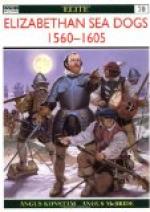The rest was slaughter, borne by the Spaniards with a resolution that nothing could surpass. With dauntless tenacity they kept their ’eagle formation,’ so useful at Lepanto, through seven dire days of most one-sided fighting. Whenever occasion seemed to offer, the Spaniards did their best to close, to grapple, and to board, as had their heroes at Lepanto. But the English merely laughed, ran in, just out of reach, poured in a shattering broadside between wind and water, stood off to reload, fired again, with equal advantage, at longer range, caught the slow galleons end-on, raked them from stem to stern, passed to and fro in one, long, deadly line-ahead, concentrating at will on any given target; and did all this with well-nigh perfect safety to themselves. In quite a different way close-to, but to the same effect at either distance, long or short, the English ‘had the range of them,’ as sailors say to-day. Close-to, the little Spanish guns fired much too high to hull the English vessels, lying low and trim upon the water, with whose changing humors their lines fell in so much more happily than those of any lumbering Spaniards could. Far-off, the little Spanish guns did correspondingly small damage, even when they managed to hit; while the heavy metal of the English, handled by real seamen-gunners, inflicted crushing damage in return.
But even more important than the Englishmen’s superiority in rig, hull, armament, and expert seamanship was their tactical use of the thoroughly modern line-ahead. Any one who will take the letter T as an illustration can easily understand the advantage of ‘crossing his T.’ The upright represents an enemy caught when in column-ahead, as he would be, for instance, when issuing from a narrow-necked port. In this formation he can only use bow fire, and that only in succession, on a very narrow front. But the fleet represented by the crosspiece, moving across the point of the upright, is in the deadly line-ahead, with all its near broadsides turned in one long converging line of fire against the helplessly narrow-fronted enemy. If the enemy, sticking to medieval tactics, had room to broaden his front by forming column-abreast, as galleys always did, that is, with several uprights side by side, he would still be at the same sort of disadvantage; for this would only mean a series of T’s with each nearest broadside crossing each opposing upright as before.
The herded soldiers and non-combatants aboard the Great Armada stood by their useless duties to the last. Thousands fell killed or wounded. Several times the Spanish scuppers actually ran a horrid red, as if the very ships were bleeding. The priests behaved as bravely as the Jesuits of New France—and who could be braver than those undaunted missionaries were? Soldiers and sailors were alike. ‘What shall we do now?’ asked Sidonia after the slaughter had gone on for a week. ’Order up more powder,’ said Oquendo, as dauntless as before. Even then the eagle formation was still kept up. The van ships were the head. The biggest galleons formed the body. Lighter vessels formed the wings. A reserve formed the tail.




